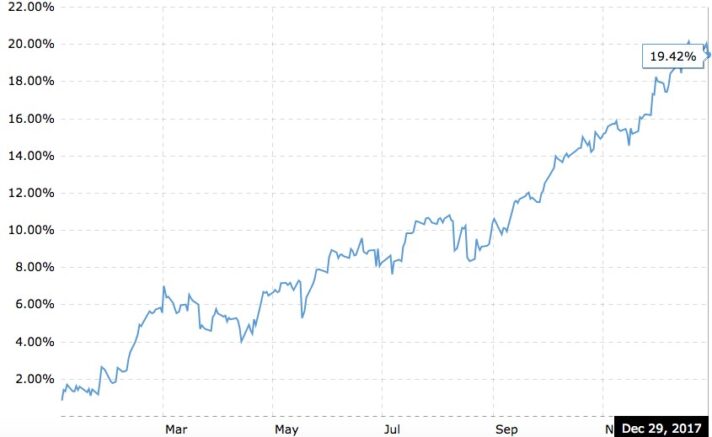The S&P 500 finished 2017 up nearly 20%.
That’s incredible.
If the market could keep that pace for the next decade, we’d all be millionaires!

I decided to take a look at two out of the 500 stocks which make up the S&P 500.
The first stock is one of the best performers, NVIDIA, which ended up 81.28% for the year.
The second stock is the worst performer, Range Resource Corp, which ended down by 50.35% for the year.
Depending on which stock you owned, you could have doubled your investment… or lost half of it!
Taking a step back, the reason for these gains (and losses) are pretty obvious.
Range Resources Corp is a petroleum and natural gas exploration and production company. With the glut of oil and gas supply on the market, profit margins have crashed in the entire industry.
Nvidia designs graphics processing units (GPUs) for the gaming, cryptocurrency, automotive, mobile computing, and professional markets. Today it seems that everyone is betting on all of those markets expanding, so Nvidia is an clear choice to add exposure to all of those industries.
But is it that simple? Is RRC a terrible company to invest in with a dark future? Is Nvidia an excellent company that will continue to rocket higher in value?
The answer to all three of those questions is, of course, “NO!”
First, as a quick disclaimer, I am not recommending either of these companies either as a buy or a short.
Instead, I’ve picked these two companies because they have a glaring valuation difference that I want to point out.
Price to book value.
Or, in simple words, I want to point out what these companies are valued at based off of their current assets.
The whole idea of investing is to identify opportunities that you think will be valued more in the future.
That’s why Nvidia has seen explosive gains this past year. Investors think that Nvidia will continue to produce products that will be in high demand, which means the company will only increase in value.
Conversely, investors think that RRC will continue to be unattractive and less profitable. That’s why their share price continues to decline.
But, what is more important for an investor? The potential amount of money they can make… or the potential amount of money they can lose?
Let’s take a look at the price to book value of each company.
Nvidia: 21.24
Range Resource Corp: 0.74
Remember, book value is the total value of the company’s assets that shareholders would theoretically receive if a company were liquidated.
So, the price to book value is how much the company is valued compared to what the actual assets are worth.
The higher that ratio, the higher the company is valued. So, based off of this metric, RRC is very cheap.
(Of course, there are many other metrics to value RRC which don’t look so attractive.)
Pretty simple. For most people, this is the best way to value any type of investment or asset.
Like I said earlier, I’m not recommending either of these stocks.
But, these two stocks are perfect examples of how markets often mis-price companies. Investors are too focused on future performances of companies versus the current realities.
The current realities are that there are MANY investments out there that have very little downside risk. They are often selling for less than the value of the actual assets in the company.
Likewise, there are many investments that are very popular right now that have little or no assets at all. Instead, investors are simply putting their money into areas where they think value will go up.
What happens if they go down? Is there any valuable asset to back up the investment? For many trendy investments right now, the answer is no.
So, before you consider what your upside potential is in any investment, first understand the downside risk.
–
Here is an idea for an investment that has very little downside risk. I’ve already invested (so have several Explorer Partnership members) and the opportunity is still available… and I’ll share more about it soon.




